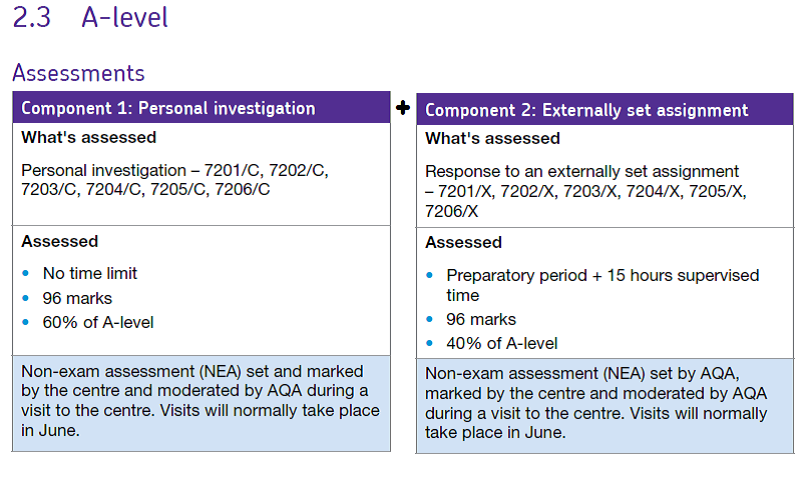Year 1 and 2 overview
| Year 1 | Year 2 | ||||
|
Autumn Term |
Spring Term | Summer Term | Autumn Term | Spring Term |
Summer Term |
|
A-level 2 years |
|||||
| Introduction to and exploration of ideas, materials, techniques and processes aiding the development of skills, knowledge and understanding.
Introduction to research skills and processes. |
Exploration of a variety of sources, materials, processes and ideas and the development of skills, knowledge and understanding. | Further exploration and development of skills and/or begin extended collection of work/project. | Start Personal investigation. | Complete Personal investigation.
Externally set assignment preparation period begins in February. |
Complete Externally set assignment. |
Assessment
Component 1: Personal Investigation
This is a practical investigation supported by written material.
Students are required to conduct a practical investigation into an idea, issue, concept or theme, supported by written material. The focus of the investigation must be identified independently by the student and must lead to a finished outcome or a series of related finished outcomes.
The investigation should be a coherent, in-depth study that demonstrates the student’s ability to construct and develop a sustained line of reasoning from an initial starting point to a final realisation.
The investigation must show clear development from initial intentions to the final outcome or outcomes.
It must include evidence of the student’s ability to research and develop ideas and relate their work in meaningful ways to relevant critical/contextual materials.
The investigation must be informed by an aspect of contemporary or past practice of artists, photographers, designers or craftspeople.
The written material must confirm understanding of creative decisions, providing evidence of all four assessment objectives by:
- clarifying the focus of the investigation
- demonstrating critical understanding of contextual and other sources
- substantiating decisions leading to the development and refinement of ideas
- recording ideas, observations and insights relevant to intentions by reflecting critically on practical work
- Making meaningful connections between, visual, written and other elements.
The written material must:
- Be a coherent and logically structured extended response of between 1000 and 3000 words of continuous prose.
- include specialist vocabulary appropriate to the subject matter
- include a bibliography that identifies contextual references from sources such as: books, journals, websites, through studies of others’ work made during a residency, or on a site, museum or gallery visit
- Be legible with accurate use of spelling, punctuation and grammar so that meaning is clear.
Annotation must not be included in the word count for the written material.
Students can present the written material as a single passage of continuous prose or as a series of shorter discrete, but linked, passages of continuous prose incorporated within the practical work.
There is no restriction on the scale of practical work produced. Students should carefully select, organise and present their work for their Personal investigation to ensure it is well structured and provides evidence that meets the requirements of all four assessment objectives.
The personal investigation will be assessed as a whole. Evidence of meeting the requirements of all four assessment objectives must be provided in both the practical and written material. Please refer to Assessing the Personal Investigation of the specification for more information on how to assess the Personal Investigation.
Students must identify and acknowledge sources which are not their own.
Component 2: Externally set assignment
Separate question papers will be provided for each title. Each question paper will consist of a choice of eight questions to be used as starting points. Students are required to select one. Students will be provided with examination papers on 1 February or as soon as possible after that date.
Preparatory period – from 1 February
Following receipt of the paper students should consider the starting points and select one. Preparatory work should be presented in any suitable format, such as mounted sheets, design sheets, sketchbooks, workbooks, journals, models and maquettes.
Supervised time – 15 hours
Following the preparatory period, students must complete 15 hours of unaided, supervised time.
The first 3 hours of the supervised time must be consecutive.
In the 15 hours students must produce a finished outcome or a series of related finished outcomes, informed by their preparatory work.
Students must stop work on their preparatory work as soon as the first period of supervised time starts.
Students may refer to their preparatory work in the supervised time, but it must not be added to or amended.
Preparatory work and the work produced in the supervised time must be kept secure in between sessions of supervised time.
The work produced during the supervised time must be clearly identified as such. Students must identify and acknowledge sources which are not their own. Annotation and/or notes should use appropriate specialist vocabulary and be legible with accurate use of language so that meaning is clear.
At the end of the 15 hours of supervised time all the work submitted for this component must be kept secure.
Preparatory work and the work produced during the 15 hours of supervised time will be assessed together, as a whole, against all four assessment objectives. Students will be assessed on their ability to work independently, working within the specified time constraints, and developing a personal and meaningful response.
There is no restriction on the scale of work produced. Students should carefully select, organise and present work to ensure that they provide evidence which meets the requirements of all four assessment objectives.


